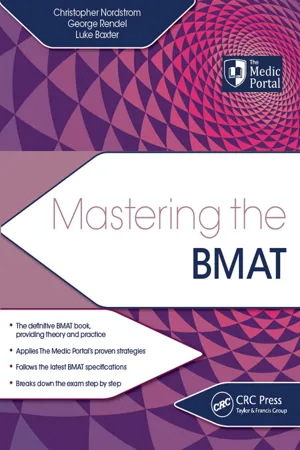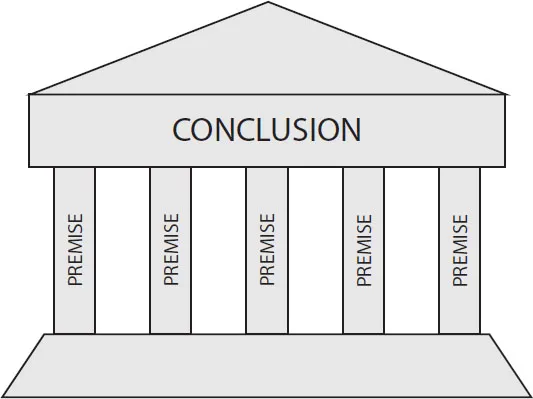
This is a test
- 218 pages
- English
- ePUB (mobile friendly)
- Available on iOS & Android
eBook - ePub
Mastering the BMAT
Book details
Book preview
Table of contents
Citations
About This Book
This is the first BMAT theory and practice book on the market, providing not only practice questions but breaking down the BMAT exam step-by-step. The authors, both leading specialists in BMAT training, focus on each section in turn, using many sample questions to carefully illustrate the theory rather than simply testing rote learning. A concluding mock exam allows candidates to consolidate learning through self-assessment, with model answers to refer to at the end.
Frequently asked questions
At the moment all of our mobile-responsive ePub books are available to download via the app. Most of our PDFs are also available to download and we're working on making the final remaining ones downloadable now. Learn more here.
Both plans give you full access to the library and all of Perlego’s features. The only differences are the price and subscription period: With the annual plan you’ll save around 30% compared to 12 months on the monthly plan.
We are an online textbook subscription service, where you can get access to an entire online library for less than the price of a single book per month. With over 1 million books across 1000+ topics, we’ve got you covered! Learn more here.
Look out for the read-aloud symbol on your next book to see if you can listen to it. The read-aloud tool reads text aloud for you, highlighting the text as it is being read. You can pause it, speed it up and slow it down. Learn more here.
Yes, you can access Mastering the BMAT by Christopher Nordstrom, George Rendel, Luke Baxter in PDF and/or ePUB format, as well as other popular books in Medicine & Medical Theory, Practice & Reference. We have over one million books available in our catalogue for you to explore.
Information
SECTION 1 | Problem solving, spatial reasoning and verbal reasoning |
Overview
The first section of the BMAT exam is designed to test aptitude. It does not require any specific knowledge, but instead is designed to assess your problem-solving abilities. Broadly speaking, questions cover logic and mathematical skills, and verbal and spatial reasoning abilities. You are, however, expected to have a solid grasp of basic mathematical principles up to GCSE level.
Format of the section
Section 1 contains 35 multiple choice questions to be answered in 60 minutes. This equates to approximately 103 seconds per question. In reality, some questions will take much longer whereas others are quite quick.
You must answer the questions on the computer-read answer sheet provided using a pencil. If you mark more than one answer option per question, you will not score any points.
Top Tip: If changing your answers, make sure you rub them out completely to prevent the computer reading two answers and therefore scoring you zero points.
Every question is worth one mark and there is no negative marking. It is therefore vital that you do not leave any questions unanswered. Competition is tight and approximately 25% of candidates will score within three marks of each other. Therefore, one mark could be the difference between success and failure.
Problem solving and verbal reasoning typically each make up approximately a third of Section 1, with the remainder of questions covering spatial reasoning and data analysis (which could include verbal, statistical and graphical information).
Question format
The questions will take one of two formats:
• Single answer
• Combination answer
Single answer questions consist of a question stem, followed by three or more answer options. Combination answer questions contain a stem, three possible answer statements and then three or more answer options involving different combinations of the answer statements.
There will also be a few longer ‘question sets’. These questions contain a large amount of information, often a combination of text and tables or graphs followed by four questions. These can be purely verbal, logical or mathematical, but often contain a mixture of question types.
Top Tip: The longer question types don’t usually require you to read all the information. The questions will point you towards the relevant part of the information.
Verbal reasoning
Verbal reasoning questions make up approximately a third of Section 1 questions. They are predominantly designed to test your understanding of arguments. It helps to have studied critical thinking when approaching these questions.
The majority of questions are single or combination answer questions, although there will usually be a few verbal reasoning questions linked to a longer question set format.

Top Tip: The BMAT Section 1 verbal questions are similar to the UKCAT ‘new format’ comprehension style questions.
The basic format of the verbal reasoning single answer questions is:
1. 100 to 150-word argument (the passage)
2. A question
3. Four or five answer options
The combination answer questions are similar, and consist of:
1. 100 to 150-word argument (the passage)
2. A question
3. Three statements
4. Three to seven answer options made from combinations of the three statements
Understanding arguments
Before attempting to answer verbal reasoning questions it’s important to understand the basic principles of an argument. In its simplest form, an argument is a set of reasons given in support of an idea or theory. In addition, you must be familiar with the definition of:
• Premises
• Conclusions
• Assumptions
• Flaws
A premise is a previous statement or proposition from which another is inferred or follows as a conclusion. A conclusion is a proposition that is reached from given premise(s). In other words, a premise can be thought of as the ‘evidence’ or ‘supporting statement’ used to justify an overall conclusion.
Below is an example of an argument:
Regular exercise reduces the rate of atherosclerosis, which in turn reduces your chance of suffering a heart attack. In addition, exercise releases endorphins which have a positive effect on mood and psychological well-being. People who exercise regularly have longer life expectancies than those with sedentary lifestyles. Therefore, exercise is beneficial to your health.
From the above example we can see that there are three premises leading to an overall conclusion:
| • Exercise reduces rates of atherosclerosis and therefore heart attacks. • Exercise improves mood through the release of endorphins. |  |
| • Regular exercise is linked to longer life expectancy. • Exercise is beneficial to health. |  |
When explaining arguments (and related questions) we will refer to the famous ancient Greek palace – the Parthenon. Visualising arguments as the Parthenon will allow you to understand how they can be attacked or strengthened.
Consider a basic argument as the Parthenon:
Just as the roof of the Parthenon is supported by the pillars, the conclusion of an argument is supported by the premises.
In Section 1 verbal reasoning there are five question formats you will encounter where you will need to identify:
• Conclusions
• Assumptions
• Flaws
• Strengthening arguments
• Weakening arguments

Conclusions
A conclusion is the proposition that is reached from given premise(s). It is important to differentiate between a conclusion and the conclusion.
A conclusion is, simply speaking, something that logically follows on from the premises. Logically follows means you cannot help but reach a particular conclusion ...
Table of contents
- Cover
- Half Title
- Title Page
- Copyright Page
- Table of Contents
- About the authors
- Introduction: Exam strategy and technique
- Section 1 – Problem solving, spatial reasoning and verbal reasoning
- Section 2 – Biology
- Section 2 – Chemistry
- Section 2 – Physics
- Section 2 – Maths
- Section 3 – Essay
- Mock BMAT exam and answers
- Index